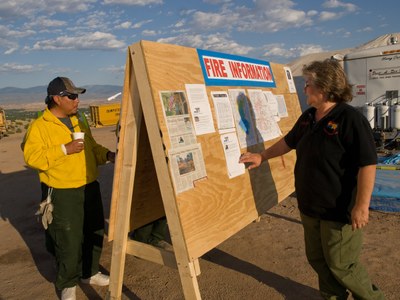Communication
 An important step in mobilizing your community after a wildfire is to develop a process of communication. Below are considerations for developing a communication plan in the wake of a destructive wildfire.
An important step in mobilizing your community after a wildfire is to develop a process of communication. Below are considerations for developing a communication plan in the wake of a destructive wildfire.
- Point of Contact: Let the appropriate people know who the Post Fire Coordinator is and how and when to reach them.
-
Communication with Multiple Entities: Determine how local officials, emergency response teams, stakeholders, and volunteers will interface and communicate with your community team built upon your needs assessment.
-
Getting the Word Out: Decide the best way to inform the broader community through outreach such as public meetings, phone calls, radio, TV or social media. Be creative and resourceful; for example, after the Tres Lagunas fire, San Miguel County Emergency Management set up local radio reporters in the canyon so residents had access to 24 hour flood alerts.
-
Online tools such as recovers.org can help you communicate with the public and match volunteers to needs.
-
Use the 'After Wildfire Toolkit' , which provides communication templates for you to customize such as door hangers, press releases and public service announcements.
-
Communicate Hazards that Exist After a Wildfire: Convey post-wildfire hazards such as those covered in immediate safety. Flooding after wildfire is a common hazard, for example. For more information on post wildfire flooding, visit our Flood Information section. For actions to take to help the land and to help mitigate flood risk, visit our Post-Fire Treatments section.
- Emergency notification: Find out if your local government and institutions (like labs and universities) have an emergency notification system that allows emergency officials to alert residents and businesses to emergency situations and relay life-saving information. Encourage your team members and residents to sign up if the system requires registration. Third party systems such as Nixle (a free alert system) also exist.
